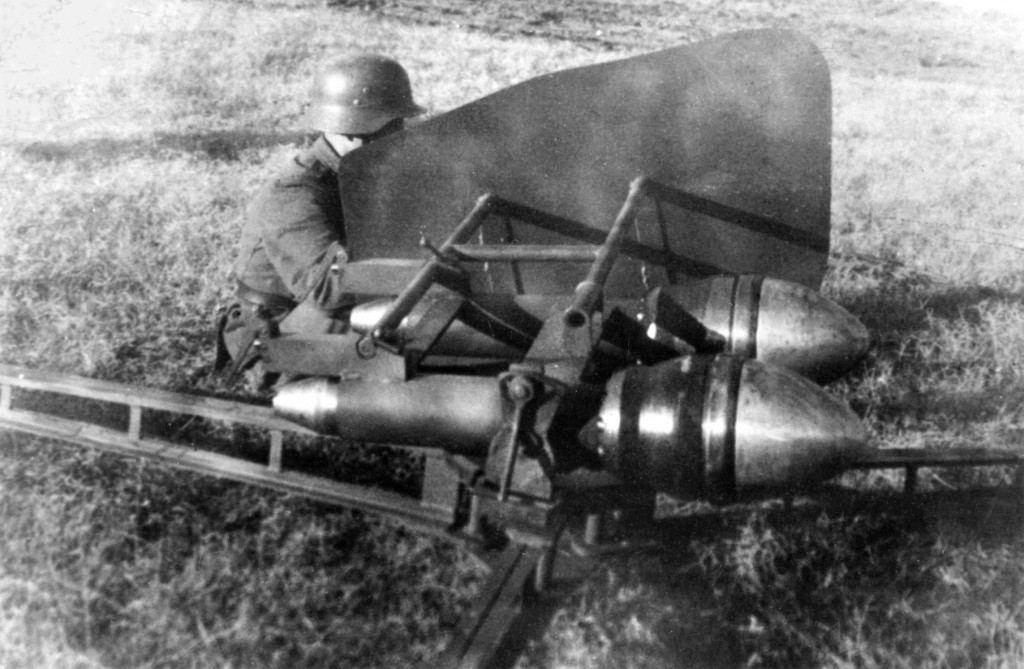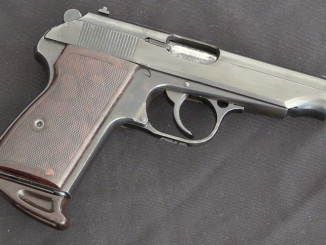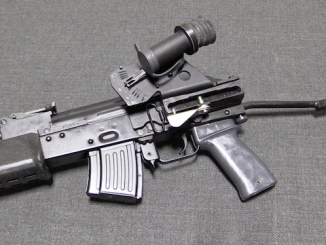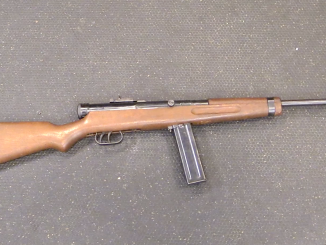
This contraption is a Hungarian M1944 (1944 Mintá = 44M) double AT Projector (dupla páncéltörövetö) aka the Buzogányvető (= the Mace). Only 700 units were made, and they served as HE/AT weapona. The warheads each hold 4.21 kg (9.27 lb) of high explosive, and the weapon could be used as a true AT weapon (the shaped charge defeated 300 mm of armor at up to 500 m) or as a sort of HE pocket howitzer (much like the original Blacker Bombard) with a range up to 1200 m. The warhead is rocket-propelled, with spin stabilization after the Nebelwerfer fashion, with angled jets around the circumference.
Thanks to Leszek for the photo and description!




giants panzerfausts ?
More like Panzerschrecks on steroids; rocket as opposed to recoilless gun system.
Of course, unlike the bazooka-type rocket, this one’s motor didn’t have to be “all burnt” as soon as it left the launcher. Early shoulder-fired AT rockets did that to avoid frying the shooter with backblast.
Modern ones, like the RPG-7s, use a recoilless charge to pop the round out of the tube, then the rocket motor lights, about 10-15 meters downrange, allowing a longer burn and greater range.
While 500m is a decent range for an unguided spin-stabilized AT rocket (a Bazooka or Panzerschreck was only usefully accurate out to about 100m vs a moving target, 250m vs. one sitting still), the indirect fire range seems a bit short for a round like this.
The 1200m indirect-fire range mentioned is much less than that of the original 15cm Nebelwerfer 41, which could “reach out” to about 6000 meters in indirect fire. The successor 21cm Nw43 added about another 1500m to that.
(Willy Ley, Rockets, Missiles, and Space Travel, Viking Press, 1951 ed., pp. 174-177.)
cheers
eon
The M72 LAW series of disposable AT rockets actually have a rocket motor that burns out in the tube just like the original Bazooka. The 84mm Carl Gustav recoilless rifle has ammunition which employ a “pure” recoilless principle, but it also has some with a “sustainer” rocket engine that engages at a safe distance from the operator. So, all the variants are still in use today.
The main problem with long burn socket motors such as the one used with RPG-7 HEAT rockets, which accelerate along the flight path, is sensitivity to crosswinds. Recoilless guns and short burn rocket projectiles tend to be somewhat less susceptible to wind.
In addition to the wind problem, long burn rockets are subject to velocity variations due to temperature differences other than the standard design temp. Cold weather causes short and low trajectories, while hot weather causes high-long shots that at the ranges claimed to be effective, cause very large miss distances. These large variations in trajectory height with range making the true recoilless and short burn rockets much more accurate.
Bofors claims the rocket assisted FFV-551, IIRC, has a range of 700 M against standing targets, but this is only possible with the laser sight and using the “Temperature compensation charts” while knowing the actual temperature! 10 Degrees difference at that range will cause a certain miss of an otherwise perfectly aimed shot.
The same sort of temperature problems also happen with the short burn and recoilless weapons, but due to the shorter ranges and faster burn times are not nearly so much problem. The longer barreled recoilless rifles with higher MVs are much less susceptible to these problems. Out in Utah and Colorado where they use them for avalanche control, they never bother with the temp comp and almost never miss the point of aim, even at very much longer ranges. After all, how much difference in trajectory can the difference between 505 and 499 M/S cause over 2000 M range?
This is one I’ve never even heard of before. The rockets definitely resemble the Nebelwerfer 41 round, but unlike it they had to have the hollow-charge warhead up front; the Nw41 round was a “nose-drive” setup, with the HE charge in the rear end of the rocket body and the angled exhausts amidship like the later Rheintochter experimental SAM.
This is obviously a ground mount (maybe experimental?), but the overhead “pipe mount” and shield on one side make me think this beast was intended to be mounted on the 251-series Hanomag halftrack, like the Wurfrahmen 40 aka “Stuka zu fuss” (“Stuka on foot”)or “Heulende Kuh” (“bellowing cow”);
http://en.wikipedia.org/wiki/Wurfrahmen_40
Even “only” 700 of them (at 4 launchers/halftrack, that’s about 150 vehicles plus 25 spare sets) would have been a nasty shock for Allied tank formations if properly used.
The most likely response would have been the tankers calling for artillery support (Red Army) or air support (everyone else in the ETO) on anything that even looked like a Hanomag packing “saddlebags”.
cheers
eon
Me too with “never seen one of those before”, bet they were easy to spot when they fired in the direct AT mode.
The ground mount looks quite substantial for a recoiless/rocket system. Was it adapted from some other weapon like a light AT/AA gun or did someone in the ordnance department decide it had to be like that because it was an AT system.
Nice find Ian, always something odd/rare or bizarre in this site. Keep up the good work 🙂
Exploded view of the innards:
http://alternathistory.org.ua/files/users/user10126/ht_1993-2003-hate0104-liderc_4.jpg
I think that the size and wight of the launcher would difficult to conceal and move, and though 500m is a more useful range than the usual infantry rocket and spigot launchers, the large, slow rocket would make the launcher easier for enemies to see, making that lack of mobility even more significant.
At least it had an ample warhead for dealing with Soviet heavy tanks, though.
By 1944, I think they would be happy with anything that would put the brakes on a IS 1 or an SU 152 or even a T 34 at any range. The mount looks simple enough to be quickly produced, and something that would be of no major loss if abandoned (which would likely happen once the firing position was revealed by the launch), unlike an anti-tank gun such as a PAK 40 or PAK 43. Regardless of its effective range, it would beat climbing up onto the turret and dropping a potato masher down the hatch (or running for your life).
Good point. A single launcher (like the manpack tube launcher for the U.S. 4.5in spin-stabilized bombardment rocket) would have made a handy expendable “ambush” weapon, sort of the ultimate “off-route” mine if set up with a remote triggering device. I.e., aim it at a road you know the tanks have to come through, when they get there, boom, then dee-dee.
cheers
eon
The ultimate in AT weapons contrived by the Third Reich was the PAW-600 AT gun. Also known as the “Pupchen, Sp?”! Little to no muzzle blast, or smoke to give away the poss, 700 M effective range, Light enough to manhandle around with three or four guys and with a HEAT warhead powerful enough to knock out any tank.
It used the HI-Low pressure system to minimize the propellant needs and deviation caused by things like temp and to a much lessor amount, wind. See this link below for more info?
http://en.wikipedia.org/wiki/8_cm_PAW_600
the puppchen is actually a rocket launcher dating from early 1943 meant to replace anti-tank rifles at the company level. Actual designation is raketenpanzerbchse 43. It is a closed breech rocket launcher mounted on a simple carriage. the rocket exhaust is re-directed by the breech forward through a space between the barrel and a sleeve. Recoil is absorbed by the mass of the carriage and the gunner sitting on the carriage. weighing in at 145kg traveling (100 kg in firing position) range was 230m useful 700 m max. Was overtaken by the much simpler panzerschrek. It saw some service as a fortress gun since panzerschek/panzerfaust can’t be fired from inside bunkers.
PAW’s didn’t enter service until 1945 and had a much longer effective range.
Just a minor correction: Puppchen was Raketenwerfer 43. Panzerschreck was Raketenpanzerbuechse.
http://ftr.wot-news.com/2014/04/02/hungarian-toldi-ii-lt-with-44m-buzoganyveto-anti-tank-rocket-launcher/
and here is all the data I could find on this thing. They put them on wheeled Maxim mounts and in, at least, one occasion on a light tank. great find Ian!
Also in Soviet Union the rocket launcher on tank was developed in 1930s – the RBT-5 based on BT-5, at least 1 prototype was build and tested:
http://bronetehnika.narod.ru/rbt5/rbt5.html
It was armed with 2 rocket (named “tank torpedo”) weighting 250kg each. Trials shows that rocket was no weaker in terms of destroying power of 305mm projectile.
Later there was also KARST system developed for KV tank, it uses RS-132 rockets.
Addition: KARST is described in English here:
http://tankarchives.blogspot.com/2014/06/karst-1.html
Wonderful find, eric – thank you! Didn’t found that one before – just the photo with brief data which I send out to Ian.
The wheeled MG mount makes a lot more sense. Nice find Eric, still wonder how useful this was.
http://topwar.ru/17515-vengerskiy-protivotankovyy-raketomet-bulava-buzoganyveto-1944-god.html
Bigger guns and missiles are more fun to shoot! And these look like too much fun to be legal most places in this country!
“the shaped charge defeated 300 mm of armor at up to 500 m”
Since a shaped charge does not rely on the round’s kinetic energy for effect and would defeat the same thickness of armor even if just placed next to it, isn’t it a little redundant to mention the range? The crux of the matter would be actually hitting the target, and spin-stabilized rockets are not exactly known for their accuracy. Perhaps even against a tank sized target, striking it at half a kilometer is slightly optimistic.
I suppose 500 meters was the “official” maximum effective range against tank sized targets. Effective ranges are notoriously dependent on the conditions and criteria chosen for effectiveness, so the 500 meters mentioned might be more or less realistic, or not. That said, I agree that it seems a little optimistic; 300 meters would sound better to me. In any case, the 500 meters figure almost certainly assumes a stationary target.